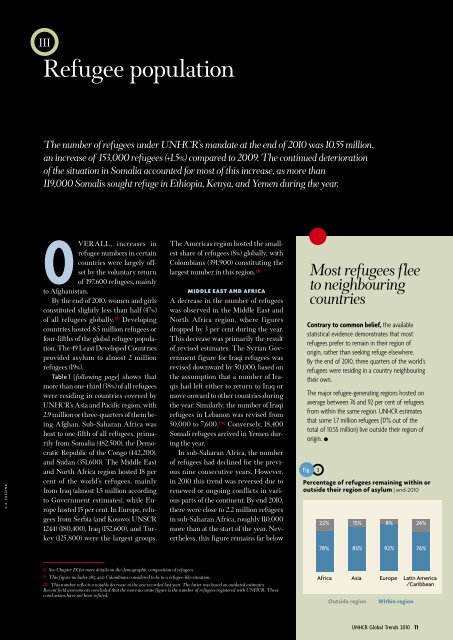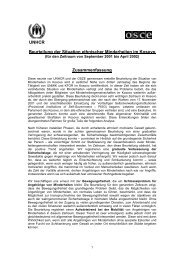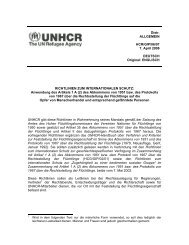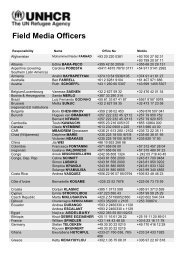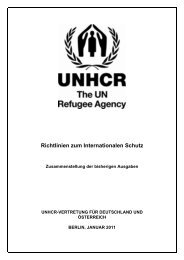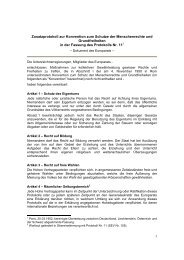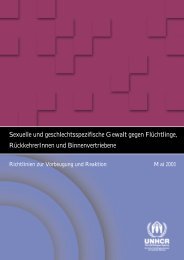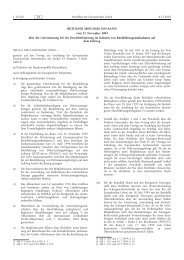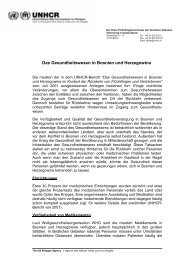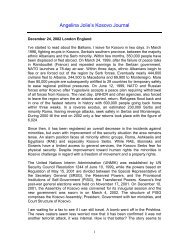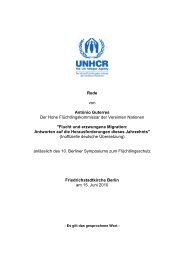EMBARGOED UNTIL MONDAY, 20 June 2011 0001 GMT ... - UNHCR
EMBARGOED UNTIL MONDAY, 20 June 2011 0001 GMT ... - UNHCR
EMBARGOED UNTIL MONDAY, 20 June 2011 0001 GMT ... - UNHCR
- No tags were found...
Create successful ePaper yourself
Turn your PDF publications into a flip-book with our unique Google optimized e-Paper software.
IIIRefugee populationThe number of refugees under <strong>UNHCR</strong>’s mandate at the end of <strong>20</strong>10 was 10.55 million,an increase of 153,000 refugees (+1.5%) compared to <strong>20</strong>09. The continued deteriorationof the situation in Somalia accounted for most of this increase, as more than119,000 Somalis sought refuge in Ethiopia, Kenya, and Yemen during the year.© A. FAZZINAOveRALL, increases inrefugee numbers in certaincountries were largely offsetby the voluntary returnof 197,600 refugees, mainlyto Afghanistan.By the end of <strong>20</strong>10, women and girlsconstituted slightly less than half (47%)of all refugees globally. (8) Developingcountries hosted 8.5 million refugees orfour-fifths of the global refugee population.The 49 Least Developed Countriesprovided asylum to almost 2 millionrefugees (19%).Table 1 [following page] shows thatmore than one-third (38%) of all refugeeswere residing in countries covered by<strong>UNHCR</strong>’s Asia and Pacific region, with2.9 million or three-quarters of them beingAfghan. Sub-Saharan Africa washost to one-fifth of all refugees, primarilyfrom Somalia (482,500), the DemocraticRepublic of the Congo (442,<strong>20</strong>0),and Sudan (351,600). The Middle Eastand North Africa region hosted 18 percent of the world’s refugees, mainlyfrom Iraq (almost 1.5 million accordingto Government estimates), while Europehosted 15 per cent. In Europe, refugeesfrom Serbia (and Kosovo: UNSCR1244) (180,400), Iraq (152,600), and Turkey(125,800) were the largest groups.The Americas region hosted the smallestshare of refugees (8%) globally, withColombians (391,900) constituting thelargest number in this region. (9)middle east and africaA decrease in the number of refugeeswas observed in the Middle East andNorth Africa region, where figuresdropped by 3 per cent during the year.This decrease was primarily the resultof revised estimates. The Syrian Governmentfigure for Iraqi refugees wasrevised downward by 50,000, based onthe assumption that a number of Iraqishad left either to return to Iraq ormove onward to other countries duringthe year. Similarly, the number of Iraqirefugees in Lebanon was revised from50,000 to 7,600. (10) Conversely, 18,400Somali refugees arrived in Yemen duringthe year.In sub-Saharan Africa, the numberof refugees had declined for the previousnine consecutive years. However,in <strong>20</strong>10 this trend was reversed due torenewed or ongoing conflicts in variousparts of the continent. By end <strong>20</strong>10,there were close to 2.2 million refugeesin sub-Saharan Africa, roughly 110,000more than at the start of the year. Nevertheless,this figure remains far belowMost refugees fleeto neighbouringcountriesContrary to common belief, the availablestatistical evidence demonstrates that mostrefugees prefer to remain in their region oforigin, rather than seeking refuge elsewhere.By the end of <strong>20</strong>10, three quarters of the world’srefugees were residing in a country neighbouringtheir own.The major refugee-generating regions hosted onaverage between 76 and 92 per cent of refugeesfrom within the same region. <strong>UNHCR</strong> estimatesthat some 1.7 million refugees (17% out of thetotal of 10.55 million) live outside their region oforigin. •Fig. 3Percentage of refugees remaining within oroutside their region of asylum | end-<strong>20</strong>1022% 15% 8% 24%78% 85% 92% 76%8 See Chapter IX for more details on the demographic composition of refugees.9 This figure includes 285,400 Colombians considered to be in a refugee-like situation.10 This number reflects a notable decrease to the one recorded last year. The latter was based on outdated estimates.Recent field assessments concluded that the more accurate figure is the number of refugees registered with <strong>UNHCR</strong>. Theseconclusions have not been refuted.Africa Asia Europe Latin America/CaribbeanOutside regionWithin region<strong>UNHCR</strong> Global Trends <strong>20</strong>10 11


